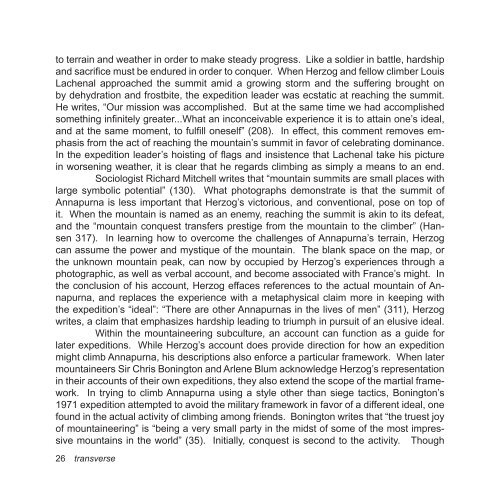Untitled - Centre for Comparative Literature - University of Toronto
Untitled - Centre for Comparative Literature - University of Toronto
Untitled - Centre for Comparative Literature - University of Toronto
You also want an ePaper? Increase the reach of your titles
YUMPU automatically turns print PDFs into web optimized ePapers that Google loves.
to terrain and weather in order to make steady progress. Like a soldier in battle, hardship<br />
and sacrifi ce must be endured in order to conquer. When Herzog and fellow climber Louis<br />
Lachenal approached the summit amid a growing storm and the suffering brought on<br />
by dehydration and frostbite, the expedition leader was ecstatic at reaching the summit.<br />
He writes, “Our mission was accomplished. But at the same time we had accomplished<br />
something infi nitely greater...What an inconceivable experience it is to attain one’s ideal,<br />
and at the same moment, to fulfi ll oneself” (208). In effect, this comment removes emphasis<br />
from the act <strong>of</strong> reaching the mountain’s summit in favor <strong>of</strong> celebrating dominance.<br />
In the expedition leader’s hoisting <strong>of</strong> fl ags and insistence that Lachenal take his picture<br />
in worsening weather, it is clear that he regards climbing as simply a means to an end.<br />
Sociologist Richard Mitchell writes that “mountain summits are small places with<br />
large symbolic potential” (130). What photographs demonstrate is that the summit <strong>of</strong><br />
Annapurna is less important that Herzog’s victorious, and conventional, pose on top <strong>of</strong><br />
it. When the mountain is named as an enemy, reaching the summit is akin to its defeat,<br />
and the “mountain conquest transfers prestige from the mountain to the climber” (Hansen<br />
317). In learning how to overcome the challenges <strong>of</strong> Annapurna’s terrain, Herzog<br />
can assume the power and mystique <strong>of</strong> the mountain. The blank space on the map, or<br />
the unknown mountain peak, can now by occupied by Herzog’s experiences through a<br />
photographic, as well as verbal account, and become associated with France’s might. In<br />
the conclusion <strong>of</strong> his account, Herzog effaces references to the actual mountain <strong>of</strong> Annapurna,<br />
and replaces the experience with a metaphysical claim more in keeping with<br />
the expedition’s “ideal”: “There are other Annapurnas in the lives <strong>of</strong> men” (311), Herzog<br />
writes, a claim that emphasizes hardship leading to triumph in pursuit <strong>of</strong> an elusive ideal.<br />
Within the mountaineering subculture, an account can function as a guide <strong>for</strong><br />
later expeditions. While Herzog’s account does provide direction <strong>for</strong> how an expedition<br />
might climb Annapurna, his descriptions also en<strong>for</strong>ce a particular framework. When later<br />
mountaineers Sir Chris Bonington and Arlene Blum acknowledge Herzog’s representation<br />
in their accounts <strong>of</strong> their own expeditions, they also extend the scope <strong>of</strong> the martial framework.<br />
In trying to climb Annapurna using a style other than siege tactics, Bonington’s<br />
1971 expedition attempted to avoid the military framework in favor <strong>of</strong> a different ideal, one<br />
found in the actual activity <strong>of</strong> climbing among friends. Bonington writes that “the truest joy<br />
<strong>of</strong> mountaineering” is “being a very small party in the midst <strong>of</strong> some <strong>of</strong> the most impressive<br />
mountains in the world” (35). Initially, conquest is second to the activity. Though<br />
26 transverse




